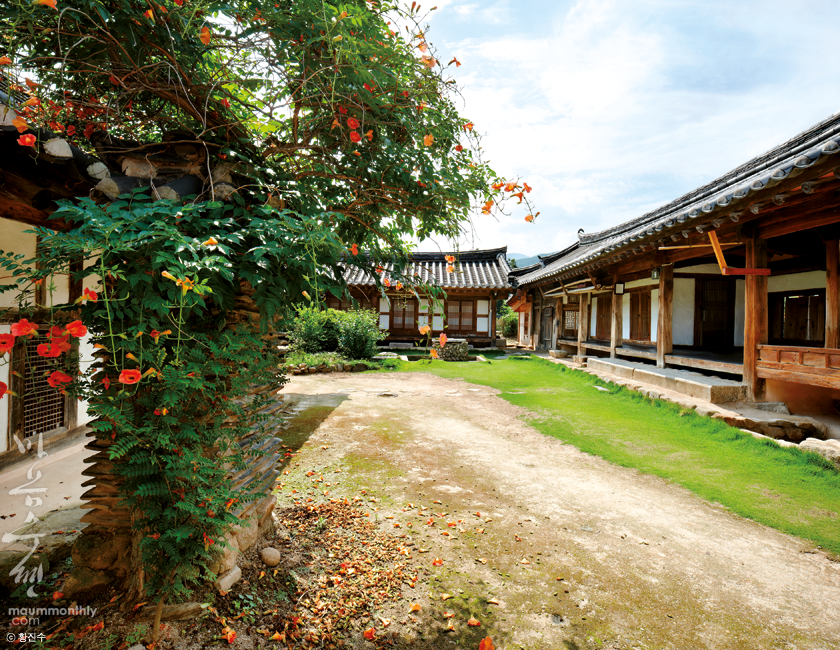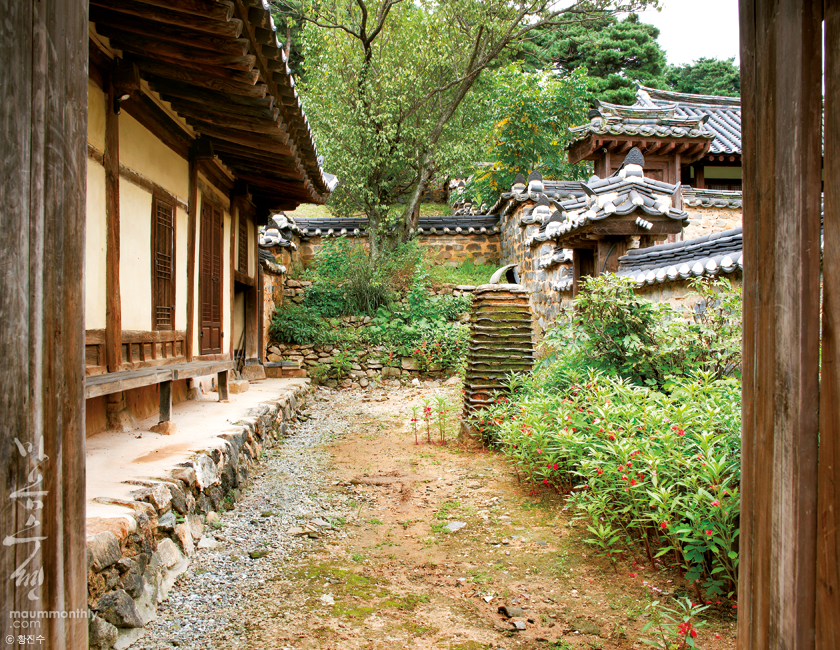
Mid-summer bae-rong tree flowers in the front yard of Myungjae-gotek in Nonsan Choong-nam. Purple-flowered makmundong is also seen.
When most people think about a garden, they think of ruler-precise gardens at Chateau de Versailles or at an Italian villa, where it takes a lot of garden work. But in our country of Korea where gardens are deep in our lives, it is difficult to distinguish where exactly it begins and ends. Our ancestors considered the nature with its mountains and streams as gardens instead of artificially made ones. Because of this, many Korean people do not know about Korean-style gardens. Written and photo by Hwang Jin-soo
Our country’s 70% of land are mountainous. They are also completely full of forests. Many mountains with elevations of 1 km or so start from Baekdoodaegan mountain ranges, up north to south; they branch down to form landscapes with many small mountains and streams. There are many charming mountains with curved rivers and streams, and exquisite rocks. Because there were such mountains within an easy view over a fence wherever you built a home, there was no need to make a separate garden at home. Our ancestors considered the beautiful nature as own gardens, rather than building one inside a home. Even if one planted flowers and trees in a front yard, they could not be compared to the beauty of flowers and trees of the mountains. So all han-ok (Korean style houses) have gardens. Typically, people say that Korean style gardens are environment- friendly, it is more correct to say that it is an unique style of gardening resulting from the characteristic landscapes.

Ildo-gotek house in hwamyang, Kyung-nam; mid-summer jacaranda has flowered by the chimney inside the inner yard of the house.
Other things also influenced the style of gardens, such as components of politics, economics, society, and culture. Chosun (old Korea), due to its deep philosophical roots (yu-gyo), emphasized stability and self-control, and suppressed luxurious gardens. Those who retired from high official positions did make adequate sized, bangjiwon-dohyung type gardens (a formation of a small round island inside a squared pond), similar to gardens of a palace. Also, garden names and formations were centered on Sungri-hak (old Chinese philosophy), Buddhism, do-gyo, shinsun ideology, topography or own ideologies and desires, etc. Bangjiwon ponds also were symbolic expressions of ideologies such as Sungri-hak and chunwon-jibang (which means sky is round and ground is square Gardens are places where a human meets the nature.

↑ Song-ha house in oeam folk village, A-san, Choong-nam; due to its wide yard, it looks like the house was built in the middle of path of pine trees. The yard has many planted flowers and looks like a wild field.
↓ Myungjae-gotek, Nonsan, Choong-nam; a flower garden under one side of a fence, coexisting of the architecture with plants is beautiful.
The nature’s gardens are complete when gazebos are built; without the gazebos, the nature is just the nature. When one builds a gazebo in a scenic area, it becomes a garden. The gazebo is a place for human beings to stay and view the nature; such is hard to find in other countries. The time of 4 years taking pictures of gardens….the nature’s embrace is always comfortable and generous and it is a healing space as well as a comfortable resting place for exhausted minds of daily life.


Hwang Jin-soo graduated from Hanyang University with a major of electric engineering and completed photographic design at Hong-ik University. Since 2001, he was active as a fashion photographer. In 2007 he started with documentary photowork of wang-gajaerae; works related to gardens were <Garden of God, Grave of Chosun King> (2009), <Korean Garden> (2012), etc. with other photoworks such as <Ten Years of Photos on the World Travel>. He plans to publish a photobook with a theme of Seoul this year.



